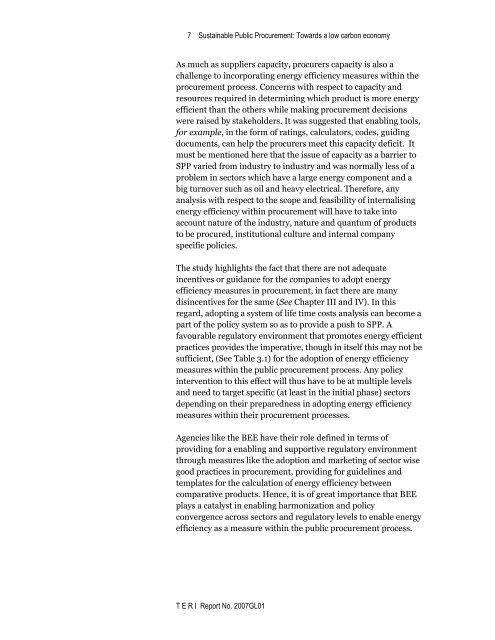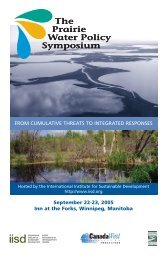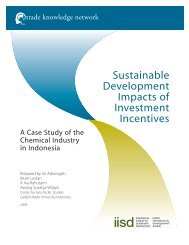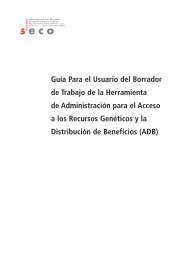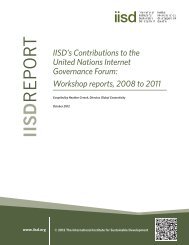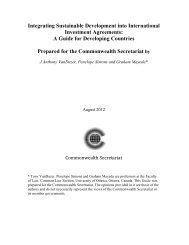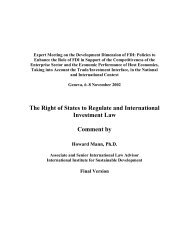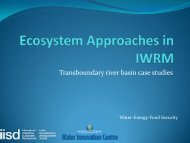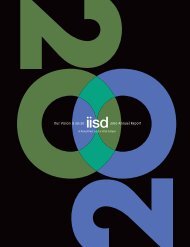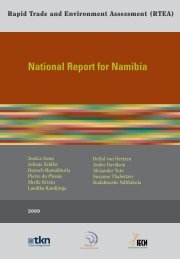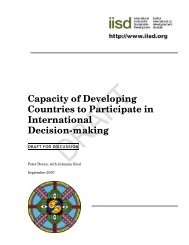Sustainable Public Procurement: Towards a lowâcarbon economy
Sustainable Public Procurement: Towards a lowâcarbon economy
Sustainable Public Procurement: Towards a lowâcarbon economy
You also want an ePaper? Increase the reach of your titles
YUMPU automatically turns print PDFs into web optimized ePapers that Google loves.
7 <strong>Sustainable</strong> <strong>Public</strong> <strong>Procurement</strong>: <strong>Towards</strong> a low carbon <strong>economy</strong><br />
As much as suppliers capacity, procurers capacity is also a<br />
challenge to incorporating energy efficiency measures within the<br />
procurement process. Concerns with respect to capacity and<br />
resources required in determining which product is more energy<br />
efficient than the others while making procurement decisions<br />
were raised by stakeholders. It was suggested that enabling tools,<br />
for example, in the form of ratings, calculators, codes, guiding<br />
documents, can help the procurers meet this capacity deficit. It<br />
must be mentioned here that the issue of capacity as a barrier to<br />
SPP varied from industry to industry and was normally less of a<br />
problem in sectors which have a large energy component and a<br />
big turnover such as oil and heavy electrical. Therefore, any<br />
analysis with respect to the scope and feasibility of internalising<br />
energy efficiency within procurement will have to take into<br />
account nature of the industry, nature and quantum of products<br />
to be procured, institutional culture and internal company<br />
specific policies.<br />
The study highlights the fact that there are not adequate<br />
incentives or guidance for the companies to adopt energy<br />
efficiency measures in procurement, in fact there are many<br />
disincentives for the same (See Chapter III and IV). In this<br />
regard, adopting a system of life time costs analysis can become a<br />
part of the policy system so as to provide a push to SPP. A<br />
favourable regulatory environment that promotes energy efficient<br />
practices provides the imperative, though in itself this may not be<br />
sufficient, (See Table 3.1) for the adoption of energy efficiency<br />
measures within the public procurement process. Any policy<br />
intervention to this effect will thus have to be at multiple levels<br />
and need to target specific (at least in the initial phase) sectors<br />
depending on their preparedness in adopting energy efficiency<br />
measures within their procurement processes.<br />
Agencies like the BEE have their role defined in terms of<br />
providing for a enabling and supportive regulatory environment<br />
through measures like the adoption and marketing of sector wise<br />
good practices in procurement, providing for guidelines and<br />
templates for the calculation of energy efficiency between<br />
comparative products. Hence, it is of great importance that BEE<br />
plays a catalyst in enabling harmonization and policy<br />
convergence across sectors and regulatory levels to enable energy<br />
efficiency as a measure within the public procurement process.<br />
T E R I Report No. 2007GL01


